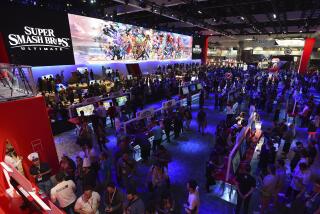Playing for Keeps
- Share via
When the mammoth Electronic Entertainment Exposition opens Thursday at the Los Angeles Convention Center, attendees will find the big three video game companies--Sony, Nintendo and Sega--squaring off like deranged aircraft carriers, with football field-size exhibits and deafening soundtracks meant to signify dominance of the world of interactive entertainment.
More difficult to spot, but much more important, are the dangerous undercurrents pulling the industry apart. The makers of video game machines are facing a mortal threat from the multimedia PC, which finally has the speed and graphics performance to make it a viable game platform. And those who create game software--for the PC or the console machines--face an overcrowded market that’s more cutthroat than ever before.
“A lot of people say this show will make or break their company,” says Doug Lowenstein, president of the Interactive Digital Software Assn., which is sponsoring the event. “Some companies that are here this year won’t be the next year. There is significant competitive pressure, and some companies won’t make it.”
The biggest question is whether a new generation of products, including a snazzy new machine from Nintendo and vastly improved software for the Sega and Sony machines introduced last year, can generate enough excitement to lure consumers back into the crumbling market.
At the end of March, there were roughly 45 million people playing video games, down from 93 million at the end of 1993, according to Fairfield Research, a Lincoln, Neb.-based market research company. Not surprisingly, the video game industry’s total sales dropped to $3.3 billion last year from about $5 billion in 1993, according to analysts.
“The home PC is making inroads into the console market,” says Gary Gabelhouse, Fairfield chief executive.
Although sales of the new 32-bit game machines are expected to triple this year to 3 million, that’s still minuscule compared with the 35 million 16-bit machines shipped during the early 1990s. By comparison, there will be 27.8 million multimedia computers in American homes by the end of this year, according to market researcher Dataquest, up from 19.8 million last year.
Microsoft has established a significant presence at E3 for the first time this year in an effort to promote its Windows 95 operating system as the ultimate gaming platform. Even without the prodding, the PC has emerged as a strong contender: Of the 1,700 new titles expected to be shown at E3, 61% will be for the PC, compared with just 24% for the various console platforms.
Still, even the PC platform is no safe haven for game developers. Since the typical PC owner buys only half a dozen CD-ROM titles over the lifetime of the machine, total sales of entertainment titles remain sluggish. Moreover, the flood of investment in multimedia in recent years means there are now 3,000 CD-ROM titles competing for shelf space.
“There was too much money spent on mediocre products,” says Bing Gordon, exective vice president at Electronic Arts.
One result of the excess supply is that distributors and retailers have become extremely powerful players in the industry, with enormous say over which products make it to the consumer.
“Large distributors are squeezing CD-ROM developers,” says Chris Weaver, president of Bethesda, a Rockville, Md.-based multimedia company. “The economies have shifted against developers and publishers.”
*
In both the PC world and the video game business, marginal producers are being edged out.
“The [industry] has had two mediocre Christmases now, and they can’t afford a third,” says Pat Ferrell, chief executive of Infotainment World, publisher of several game magazines and a sponsor of E3.
On the hardware side, most observers expect the Atari Jaguar and 3DO game platforms to fade away. Some even predict that one of the big three console makers could be forced out of the race.
“We’ve always said that there is only room for two survivors,” says Jim Whims, executive vice president at Sony Computer Entertainment.
On the software side, hundreds of game developers will probably be forced to turn to larger companies to survive.
A wave of consolidation is underway all across the computer software business, and entertainment software firms are hurriedly buying and merging.
Still, when the smoke clears, the survivors could be left with a healthier market.
“There will be a Gestalt emerging from all this sound and fury that the market is alive and well,” says Robert Holmes, president of Acclaim, a leading game developer based in Long Island, N.Y.
Nintendo, which has $2 billion in the bank to make sure it is one of the survivors, figures things are already looking up. Peter Main, marketing vice president at Nintendo, points out that industry sales showed a 10% uptick in the first quarter of 1996 over the year before--the first such increase in years.
“We’re pleased as heck with this kind of turnaround,” Main says. Even though Nintendo won’t have its new machine on the market until the fall, Main thinks the improved market, which he projected will grow 17% this year, could persuade retailers to break open more shelf space for video game products.
Nintendo has little doubt that its machine, along with the six titles it releases, will get prominent display.
Trip Hawkins, the 3DO chief executive who has long been skeptical of Nintendo’s new machine, has changed his tune after seeing the company’s new Mario game.
Nintendo 64 “could be a hit just based on this game,” Hawkins says.
Sega and Sony think their wide selection of second-generation games will be more than enough to stave off competition from Nintendo. Sony’s Whims says the company expects 125 to 150 new titles to come out for the PlayStation, which was introduced last fall.
The big boost in video game sales could come from lower prices. When the new-generation machines came out three years ago with prices at $400 and above, they found few takers.
Now the prices have come down to about $300. At the show, Nintendo will price its new machine at less than $250, and Sega is expected to drop the price of its system to less than $200.
“You’ll continue to see people subsidize the prices of their machines,” says Randy Commissar, chief executive at San Francisco-based game maker Crystal Research. “You’re going to see good growth.”
Still, it’s unclear how much manufacturers will be willing to lose.
The previous-generation machines never hit mass markets until their prices fell closer to $100. Packed as they are with memory chips and CD-ROM drives, the new game machines are unlikely to get that cheap.
By contrast, multimedia PCs, already in a growing number of homes, are reaching a broader audience.
Whereas Nintendo mania initially focused on the 8-to-13-year-old group--and a new generation of games has attracted some into their early 20s--on the PC there are titles that target everyone from the 6-month-old to the senior citizen.
*
And with the number of multimedia machines being sold in Europe and Japan taking off, CD-ROM makers hope to spread their development costs over a broader audience.
Byron Preiss Multimedia of New York has taken advantage of the trend by establishing ventures with British and German publishers to help raise capital and distribute the finished product. Dallas-based game developer 7th level figures its new Monty Python title will ultimately get as much as 40% of its sales from overseas markets such as Britain and Germany.
“When you get into the global stage, you can afford to do a bigger title,” says Chief Executive Byron Preiss.
If consoles represent the dominant interactive game form of the past and CD-ROMs for PCs are the present, the World Wide Web may be the platform of the future. A slew of companies will be showing systems that allow users to play games online.
“We’ve embraced the interactive experience,” says Bob Ezrin, chief executive at 7th level. “We just don’t know how we are going to deliver it.”
That may be the real battle that is waged at E3 this week.
Leslie Helm can be reached via e-mail at leslie.helm@latimes.com
(BEGIN TEXT OF INFOBOX / INFOGRAPHIC)
Over the Slump
Sales of video game hardware and software are expected to climb during the next few years.
Total worldwide revenue of video software:
Revenue, in billions
1992: $3.2
1993: $3.7
1994: $3.1
1995: $3.2
1996: $3.6
1997: $3.8
1998: $4.8
1999: $6.4
2000: $7.2
Total worldwide revenue of video hardware:
Revenue, in billions
1992: $2.0
1993: $2.1
1994: $1.8
1995: $1.7
1996: $1.6
1997: $1.7
1998: $1.6
1999: $2.4
2000: $2.0
Note: Figures for 1996-2000 are projections.
Source: Dataquest
More to Read
The biggest entertainment stories
Get our big stories about Hollywood, film, television, music, arts, culture and more right in your inbox as soon as they publish.
You may occasionally receive promotional content from the Los Angeles Times.










